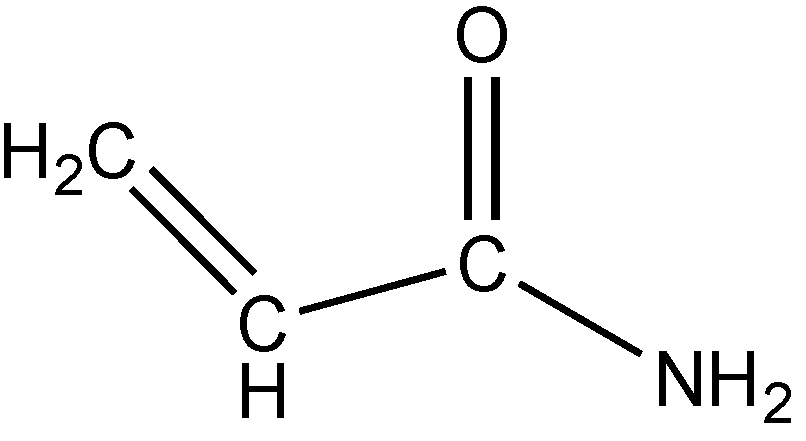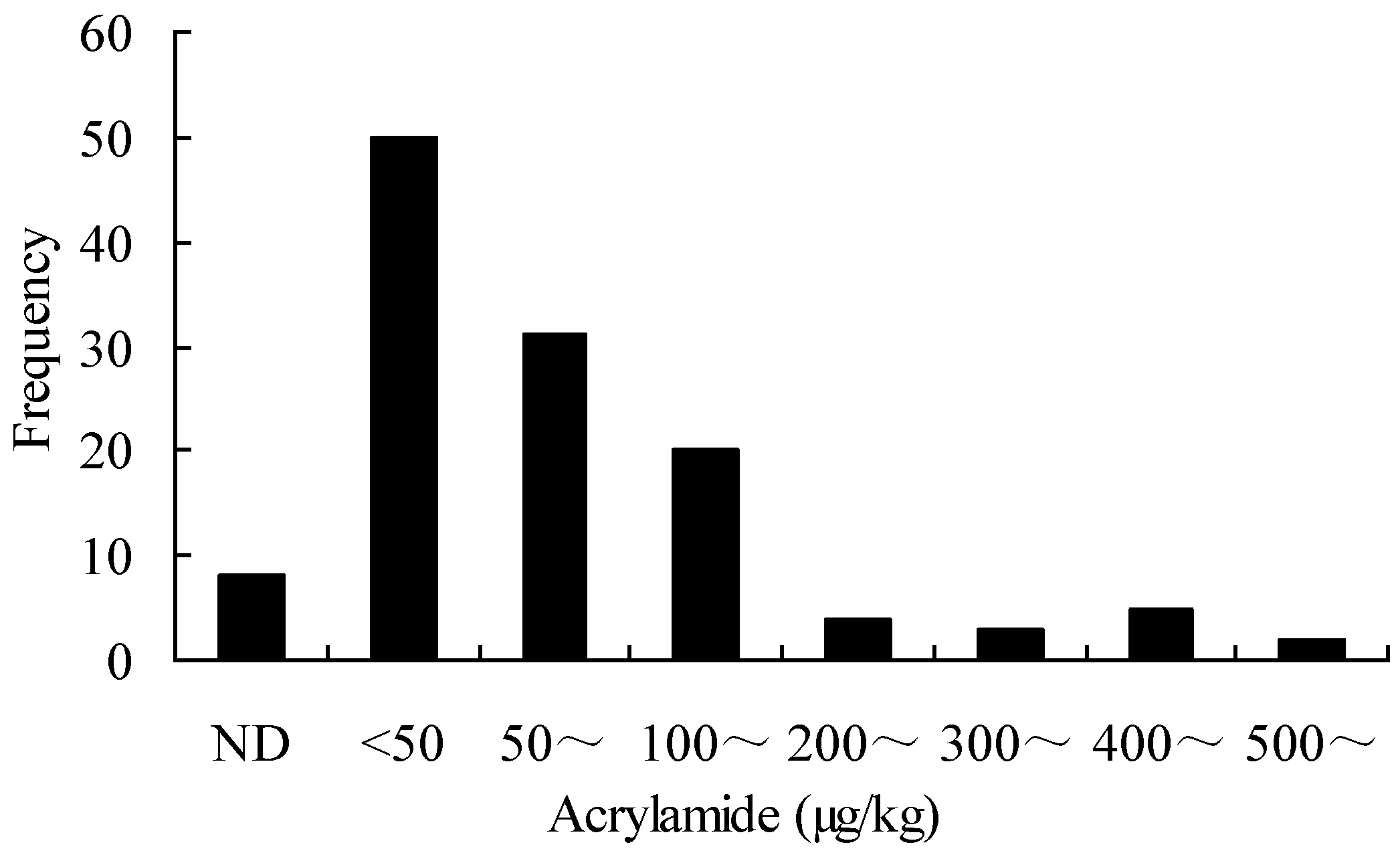Evaluation of Acrylamide in Food from China by a LC/MS/MS Method
Abstract
:1. Introduction

2. Experimental
2.1. Chemicals
2.2. Apparatus
2.3. Sample Treatment
2.4. Acrylamide Analysis
2.5. Statistical Analysis
3. Results and Discussion
3.1. Validation of the Analytical Method
| Linear range | R2 | LOD (μg/kg) | RSD (%) | Recovery (%) |
|---|---|---|---|---|
| 20~200 μg/L | 0.9988 | 2.4 | 3.5 | 91~97 |
3.2. The Occurrence and Levels of Acrylamide in Foods

| Category | Samples Tested | Samples Positive | Level of Acrylamide (µg/kg) | |||
|---|---|---|---|---|---|---|
| Mean | SD | Min | Max | |||
| Soybean paste | 4 | 4 | 13.70 | 8.39 | 4.08 | 24.40 |
| Processed meat | 6 | 6 | 22.62 | 20.10 | 2.31 | 49.06 |
| Rice roll and noodle | 11 | 9 | 23.22 | 15.19 | 9.12 | 52.09 |
| Cooked meat | 5 | 5 | 25.03 | 21.97 | 2.71 | 78.57 |
| Sauted nut | 8 | 7 | 25.14 | 19.09 | 4.04 | 54.66 |
| Roasted bread | 5 | 5 | 36.72 | 26.54 | 10.50 | 67.19 |
| Wafer biscuit | 6 | 5 | 44.92 | 33.86 | 10.36 | 86.76 |
| Roasted rice cake | 6 | 6 | 68.34 | 65.75 | 16.82 | 196.46 |
| Pancake | 8 | 7 | 70.33 | 127.86 | 1.88 | 352.90 |
| Roasted biscuit | 24 | 23 | 97.57 | 103.71 | 0.41 | 484.17 |
| Crisp | 11 | 9 | 137.91 | 119.68 | 17.39 | 398.23 |
| Fried flour snack | 8 | 8 | 131.73 | 122.75 | 39.12 | 432.92 |
| Fried rice crust | 8 | 8 | 201.51 | 122.62 | 100.46 | 491.76 |
| Fried prawn strips | 4 | 4 | 341.40 | 122.95 | 166.25 | 439.44 |
| Fried potato | 9 | 9 | 604.27 | 1,327.87 | 58.40 | 4,126.26 |
| Total | 123 | 115 | 94.16 | 54.74 | 0.41 | 4,126.26 |
| Sample | Acylamide Level | References |
|---|---|---|
| Breakfast cereals | <62–803 μg/kg | [18] |
| Carbohydrate-rich food | <20–2,528 μg/kg | [16] |
| Potato crisps | 325 μg/kg | [17] |
| Espresso coffee | 11.4–36.2 μg/L | [20] |
| Chocolate | 102 μg/kg | [19] |
| Pizza, minced meat, fried bacon | 0–1,480 μg/kg | [28] |
| Baby strained prunes | 75–265 μg/kg | [29] |
4. Conclusions
Acknowledgments
Conflict of Interest
References
- Gamboa, R.T.; Gamboa, A.R.; Bravo, A.H.; Ostrosky, W.P. Genotoxicity in child populations exposed to polycyclic aromatic hydrocarbons (PAHs) in the air from Tabasco, Mexico. Int. J. Environ. Res. Public Health 2008, 5, 349–355. [Google Scholar] [CrossRef]
- Li, P.; Feng, X.; Qiu, G. Methylmercury exposure and health effects from rice and fish consumption: A review. Int. J. Environ. Res. Public Health 2010, 7, 2666–2691. [Google Scholar] [CrossRef]
- Xia, E.Q.; Chen, Y.H.; Xu, X.R.; Li, S.; Deng, G.F.; Li, H.B. Analytical methods and contents of polycyclic aromatic hydrocarbons in food. Int. J. Food Nutr. Saf. 2012, 1, 1–8. [Google Scholar]
- Xia, E.Q.; Xu, X.R.; Chen, Y.H.; Wu, S.; Deng, G.F.; Zou, Z.F.; Li, S.; Li, H.B. Occurrence and analytical methods of acrylamide in food. Int. J. Food Nutr. Saf. 2012, 1, 26–38. [Google Scholar]
- Li, S.; Wu, S.; Chen, Y.H.; Xu, X.R.; Deng, G.F.; Xia, E.Q.; Zhou, J.; Li, H.B. Source and analytical methods of chloropropanols in food. Int. J. Food Nutr. Saf. 2012, 1, 107–119. [Google Scholar]
- Guo, X.; Yan, H.; Zhu, L.; Zeng, L.; Xiong, F.; Yan, H. Effects of acrylamide on rat neurobehavior, the contents of dopamine and its metabolites in nigrostriatal dopaminergic pathways. J. Hyg. Res. 2011, 40, 441–444. [Google Scholar]
- Seale, S.M.; Feng, Q.; Agarwal, A.K.; El-Alfy, A.T. Neurobehavioral and transcriptional effects of acrylamide in juvenile rats. Pharmacol. Biochem. Behav. 2011, 101, 77–84. [Google Scholar]
- Johnson, K.A.; Gorzinski, S.J.; Bodner, K.M.; Campbell, R.A.; Wolf, C.H.; Friedman, M.A. Chronic toxicity and oncogenicity study on acrylamide incorporated in the drinking water of Fischer 344 rats. Mast RW. Toxicol. Appl. Pharmacol. 1986, 85, 154–168. [Google Scholar] [CrossRef]
- Zhang, X. Simultaneous exposure to dietary acrylamide and corn oil developed carcinogenesis through cell proliferation and inhibition of apoptosis by regulating p53-mediated mitochondria-dependent signaling pathway. Toxicol. Ind. Health 2009, 25, 101–109. [Google Scholar] [CrossRef]
- Arihan, O.; Seringec, N.B.; Gurel, E.I.; Dikmenoglu, N.H. Effects of oral acrylamide intake on blood viscosity parameters in rats. Clin. Hemorheol. Microcirc. 2011, 47, 45–52. [Google Scholar]
- Jiang, L.; Cao, J.; An, Y.; Geng, C.; Qu, S.; Jiang, L.; Zhong, L. Genotoxicity of acrylamide in human hepatoma G2 (HepG2) cells. Toxicol. In Vitro 2007, 21, 1486–1492. [Google Scholar] [CrossRef]
- Yener, Y.; Dikmenli, M. The effects of acrylamide on the frequency of megakaryocytic emperipolesis and the mitotic activity of rat bone marrow cells. J. Sci. Food Agri. 2011, 91, 1810–1813. [Google Scholar] [CrossRef]
- IARC, IARC Monographs on the Evaluation of Carcinogenic Risks to Humans. In Acrylamide, Summary of Data Reported and Evaluation; IARC: Lyon, France, 1994; p. 389.
- Tareke, E.; Rydberg, P.; Karlsson, S.; Eriksson, S.; Tornqvist, M. Analysis of acrylamide, a carcinogen formed in heated foodstuffs. J. Agric. Food Chem. 2002, 50, 4998–5006. [Google Scholar] [CrossRef]
- Mottram, D.S.; Wedzicha, B.L.; Dodson, A.T. Acrylamide is formed in the Maillard reaction. Nature 2002, 419, 448–449. [Google Scholar]
- Arisseto, A.P.; Toledo, M.C.; Govaert, Y.; Loco, J.V.; Fraselle, S.; Weverbergh, E.; Degroodt, J.M. Determination of acrylamide levels in selected foods in Brazil. Food Addit. Contam. 2007, 24, 236–241. [Google Scholar] [CrossRef]
- Bermudo, E.; Nunez, O.; Puignou, L.; Galceran, M.T. Analysis of acrylamide in food products by in-line preconcentration capillary zone electrophoresis. J. Chromatogr. A 2006, 1129, 129–134. [Google Scholar]
- Bermudo, E.; Moyano, E.; Puignou, L.; Galceran, M.T. Liquid chromatography coupled to tandem mass spectrometry for the analysis of acrylamide in typical Spanish products. Talanta. 2008, 76, 389–394. [Google Scholar] [CrossRef]
- Pardo, O.; Yusa, V.; Coscolla, C.; Leon, N.; Pastor, A. Determination of acrylamide in coffee and chocolate by pressurised fluid extraction and liquid chromatography-tandem mass spectrometry. Food Addit. Contam. 2007, 24, 663–672. [Google Scholar] [CrossRef]
- Soares, C.; Cunha, S.; Fernandes, J. Determination of acrylamide in coffee and coffee products by GC-MS using an improved SPE clean-up. Food Addit. Contam. 2006, 23, 1276–1282. [Google Scholar] [CrossRef]
- Zhang, Y.; Ren, Y.; Zhao, H.; Zhang, Y. Determination of acrylamide in Chinese traditional carbohydrate-rich foods using gas chromatography with micro-electron capture detector and isotope dilution liquid chromatography combined with electrospray ionization tandem mass spectrometry. Anal. Chim. Acta. 2007, 584, 322–332. [Google Scholar] [CrossRef]
- Jiao, J.; Zhang, Y.; Ren, Y.; Wu, X.; Zhang, Y. Development of a quantitative method for determination of acrylamide in infant powdered milk and baby foods in jars using isotope dilution liquid chromatography/electrospray ionization tandem mass spectrometry. J. Chromatogr. A 2005, 1099, 198–202. [Google Scholar]
- Xia, E.Q.; Song, Y.; Ai, X.X.; Guo, Y.J.; Xu, X.R.; Li, H.B. A new high-performance liquid chromatographic method for the determination and distribution of linalool in Michelia Alba. Molecules 2010, 15, 4890–4897. [Google Scholar] [CrossRef]
- Olmez, H.; Tuncay, F.; Ozcan, N.; Demirel, S. A survey of acrylamide levels in foods from the Turkish market. J. Food Compos. Anal. 2008, 21, 564–568. [Google Scholar] [CrossRef]
- Stadler, R.H.; Blank, I.; Varga, N.; Robert, F.; Hau, J.; Guy, P.A.; Robert, M.C.; Riediker, S. Acrylamide from Maillard reaction products. Nature 2002, 419, 449–450. [Google Scholar]
- Koutsidis, G.; De la Fuente, A.; Dimitriou, C.; Kakoulli, A.; Wedzicha, B.L.; Mottram, D.S. Acrylamide and pyrazine formation in model systems containing asparagines. J. Agric. Food Chem. 2008, 56, 6105–6012. [Google Scholar]
- Summa, C.; Wenzl, T.; Brohee, M.; De La Calle, B.; Anklam, E. Investigation of the correlation of the acrylamide content and the antioxidant activity of model cookies. J. Agric. Food Chem. 2006, 54, 853–859. [Google Scholar] [CrossRef]
- Eerola, S.; Hollebekkers, K.; Hallikainen, A.; Peltonen, K. Acrylamide levels in Finnish foodstuffs analysed with liquid chromatography tandem mass spectrometry. Mol. Nutr. Food Res. 2007, 51, 239–247. [Google Scholar] [CrossRef]
- Pedersen, J.R.; Olsson, J.O. Soxhlet extraction of acrylamide from potato chips. Analyst 2003, 128, 332–334. [Google Scholar] [CrossRef]
© 2012 by the authors; licensee MDPI, Basel, Switzerland. This article is an open-access article distributed under the terms and conditions of the Creative Commons Attribution license (http://creativecommons.org/licenses/by/3.0/).
Share and Cite
Chen, Y.-H.; Xia, E.-Q.; Xu, X.-R.; Ling, W.-H.; Li, S.; Wu, S.; Deng, G.-F.; Zou, Z.-F.; Zhou, J.; Li, H.-B. Evaluation of Acrylamide in Food from China by a LC/MS/MS Method. Int. J. Environ. Res. Public Health 2012, 9, 4150-4158. https://doi.org/10.3390/ijerph9114150
Chen Y-H, Xia E-Q, Xu X-R, Ling W-H, Li S, Wu S, Deng G-F, Zou Z-F, Zhou J, Li H-B. Evaluation of Acrylamide in Food from China by a LC/MS/MS Method. International Journal of Environmental Research and Public Health. 2012; 9(11):4150-4158. https://doi.org/10.3390/ijerph9114150
Chicago/Turabian StyleChen, Yong-Hong, En-Qin Xia, Xiang-Rong Xu, Wen-Hua Ling, Sha Li, Shan Wu, Gui-Fang Deng, Zhi-Fei Zou, Jing Zhou, and Hua-Bin Li. 2012. "Evaluation of Acrylamide in Food from China by a LC/MS/MS Method" International Journal of Environmental Research and Public Health 9, no. 11: 4150-4158. https://doi.org/10.3390/ijerph9114150





